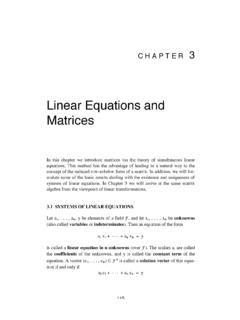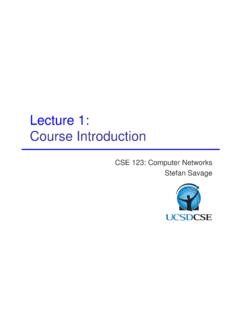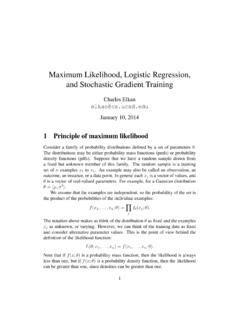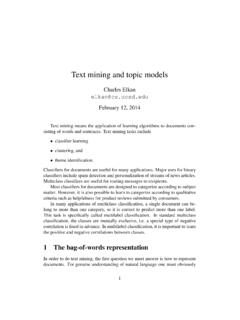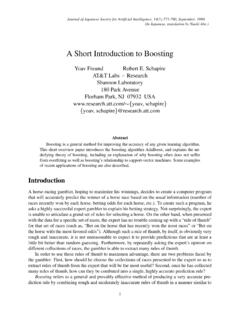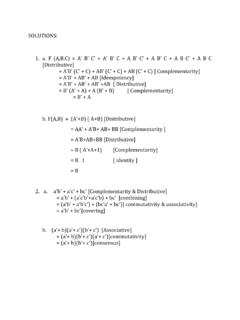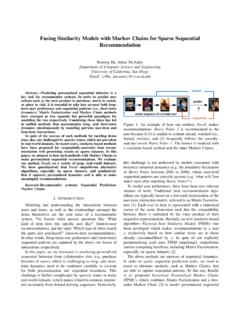Transcription of Lecture 6: Semaphores and Monitors
1 Lecture 6: Lecture 6: Semaphores and MonitorsSemaphores and MonitorsCSE 120: Principles of Operating SystemsAlex C. SnoerenHW 2 Due Tuesday 10/18 CSE 120 Lecture 62 Higher-Level SynchronizationHigher-Level Synchronization We looked at using locks to provide mutual exclusion Locks work, but they have some drawbacks whencritical sections are long Spinlocks inefficient Disabling interrupts can miss or delay important events Instead, we want synchronization mechanisms that Block waiters Leave interrupts enabled inside the critical section Look at two common high-level mechanisms Semaphores : binary (mutex) and counting Monitors : mutexes and condition variables Use them to solve common synchronization problemsCSE 120 Lecture 63 SemaphoresSemaphores Semaphores are another data structure that providesmutual exclusion to critical sections Block waiters, interrupts enabled within CS Described by Dijkstra in THE system in 1968 Semaphores can also be used as atomic counters More later Semaphores support two operations: wait(semaphore): decrement, block until semaphore is open Also P(), after the Dutch word for test, or down() signal(semaphore).
2 Increment, allow another thread to enter Also V() after the Dutch word for increment, or up()CSE 120 Lecture 64 Blocking in SemaphoresBlocking in Semaphores Associated with each semaphore is a queue of waitingprocesses When wait() is called by a thread: If semaphore is open, thread continues If semaphore is closed, thread blocks on queue Then signal() opens the semaphore: If a thread is waiting on the queue, the thread is unblocked If no threads are waiting on the queue, the signal isremembered for the next thread In other words, signal() has history ( condition vars later) This history is a counterCSE 120 Lecture 65 Semaphore TypesSemaphore Types Semaphores come in two types Mutex semaphore Represents single access to a resource Guarantees mutual exclusion to a critical section Counting semaphore Represents a resource with many units available, or aresource that allows certain kinds of unsynchronizedconcurrent access ( , reading)
3 Multiple threads can pass the semaphore Number of threads determined by the semaphore count mutex has count = 1, counting has count = NCSE 120 Lecture 66 Using SemaphoresUsing Semaphores Use is similar to our locks, but semantics are differentstruct Semaphore { int value; Queue q;} S;withdraw (account, amount) { wait(S); balance = get_balance(account); balance = balance amount; put_balance(account, balance); signal(S); return balance;}wait(S);balance = get_balance(account);balance = balance amount;wait(S);put_balance(account, balance);signal(S);wait(S);..signal(S);. .signal(S);ThreadsblockIt is undefined whichthread runs after a signalCSE 120 Lecture 67 Semaphores in NachosSemaphores in Nachos thread_sleep() assumes interrupts are disabled Note that interrupts are disabled only to enter/leave critical section How can it sleep with interrupts disabled?
4 Need to be able to reference current threadwait (S) { Disable interrupts; while (S->value == 0) { enqueue(S->q, current_thread); thread_sleep(current_thread); } S->value = S->value 1; Enable interrupts;}signal (S) { Disable interrupts; thread = dequeue(S->q); thread_start(thread); S->value = S->value + 1; Enable interrupts;}CSE 120 Lecture 68 Using SemaphoresUsing Semaphores We ve looked at a simple example for usingsynchronization Mutual exclusion while accessing a bank account Now we re going to use Semaphores to look at moreinteresting examples Readers/Writers Bounded BuffersCSE 120 Lecture 69 Readers/Writers ProblemReaders/Writers Problem Readers/Writers Problem: An object is shared among several threads Some threads only read the object, others only write it We can allow multiple readers But only one writer How can we use Semaphores to control access to theobject to implement this protocol?
5 Use three variables int readcount number of threads reading object Semaphore mutex control access to readcount Semaphore w_or_r exclusive writing or readingCSE 120 Lecture 610// number of readersint readcount = 0;// mutual exclusion to readcountSemaphore mutex = 1;// exclusive writer or readerSemaphore w_or_r = 1;writer { wait(w_or_r); // lock out readers Write; signal(w_or_r); // up for grabs}Readers/WritersReaders/Writersread er { wait(mutex); // lock readcount readcount += 1; // one more reader if (readcount == 1) wait(w_or_r); // synch w/ writers signal(mutex); // unlock readcount Read; wait(mutex); // lock readcount readcount -= 1; // one less reader if (readcount == 0) signal(w_or_r); // up for grabs signal(mutex); // unlock readcount}}CSE 120 Lecture 611 Readers/Writers NotesReaders/Writers Notes If there is a writer First reader blocks on w_or_r All other readers block on mutex Once a writer exits, all readers can fall through Which reader gets to go first?
6 The last reader to exit signals a waiting writer If no writer, then readers can continue If readers and writers are waiting on w_or_r, and awriter exits, who goes first? Why doesn t a writer need to use mutex?CSE 120 Lecture 612 Bounded BufferBounded Buffer Problem: There is a set of resource buffers shared byproducer and consumer threads Producer inserts resources into the buffer set Output, disk blocks, memory pages, processes, etc. Consumer removes resources from the buffer set Whatever is generated by the producer Producer and consumer execute at different rates No serialization of one behind the other Tasks are independent (easier to think about) The buffer set allows each to run without explicit handoffCSE 120 Lecture 613 Bounded Buffer (2)Bounded Buffer (2) Use three Semaphores : mutex mutual exclusion to shared set of buffers Binary semaphore empty count of empty buffers Counting semaphore full count of full buffers Counting semaphoreCSE 120 Lecture 614producer { while (1) { Produce new resource; wait(empty); // wait for empty buffer wait(mutex); // lock buffer list Add resource to an empty buffer; signal(mutex).}}
7 // unlock buffer list signal(full); // note a full buffer }}Bounded Buffer (3)Bounded Buffer (3)consumer { while (1) { wait(full); // wait for a full buffer wait(mutex); // lock buffer list Remove resource from a full buffer; signal(mutex); // unlock buffer list signal(empty); // note an empty buffer Consume resource; }}Semaphore mutex = 1; // mutual exclusion to shared set of buffersSemaphore empty = N; // count of empty buffers (all empty to start)Semaphore full = 0; // count of full buffers (none full to start)CSE 120 Lecture 615 Bounded Buffer (4)Bounded Buffer (4) Why need the mutex at all? Where are the critical sections? What happens if operations on mutex and full/emptyare switched around?
8 The pattern of signal/wait on full/empty is a common constructoften called an interlock Producer-Consumer and Bounded Buffer are classicexamples of synchronization problems The Mating Whale problem in Project 1 is another You can use Semaphores to solve the problem Use readers/writers and bounded buffer as examples for hwCSE 120 Lecture 616 Semaphore SummarySemaphore Summary Semaphores can be used to solve any of thetraditional synchronization problems However, they have some drawbacks They are essentially shared global variables Can potentially be accessed anywhere in program No connection between the semaphore and the data beingcontrolled by the semaphore Used both for critical sections (mutual exclusion) andcoordination (scheduling) No control or guarantee of proper usage Sometimes hard to use and prone to bugs Another approach: Use programming language supportCSE 120 Lecture 617 MonitorsMonitors A monitor is a programming language construct thatcontrols access to shared data Synchronization code added by compiler, enforced at runtime Why is this an advantage?
9 A monitor is a module that encapsulates Shared data structures Procedures that operate on the shared data structures Synchronization between concurrent procedure invocations A monitor protects its data from unstructured access It guarantees that threads accessing its data throughits procedures interact only in legitimate waysCSE 120 Lecture 618 monitor SemanticsMonitor Semantics A monitor guarantees mutual exclusion Only one thread can execute any monitor procedure at anytime (the thread is in the monitor ) If a second thread invokes a monitor procedure when a firstthread is already executing one, it blocks So the monitor has to have a wait If a thread within a monitor blocks, another one can enter What are the implications in terms of parallelism inmonitor?
10 CSE 120 Lecture 619 Account ExampleAccount Example Hey, that was easy But what if a thread wants to wait inside the monitor ? Such as mutex(empty) by reader in bounded buffer? monitor account { double balance; double withdraw(amount) { balance = balance amount; return balance; }}withdraw(amount) balance = balance amount;withdraw(amount) return balance (and exit)withdraw(amount) balance = balance amount return balance; balance = balance amount; return balance;Threadsblockwaitingto getintomonitorWhen first thread exits, another canenter. Which one is 120 Lecture 620 Condition VariablesCondition Variables Condition variables provide a mechanism to wait forevents (a rendezvous point ) Resource available, no more writers, etc.

